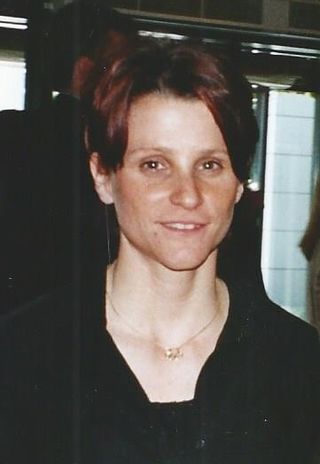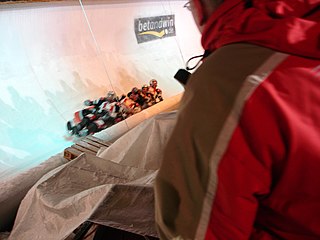Related Research Articles

St. Moritz is a high Alpine resort town in the Engadine in Switzerland, at an elevation of about 1,800 metres (5,910 ft) above sea level. It is Upper Engadine's major town and a municipality in the administrative region of Maloja in the Swiss canton of Graubünden.

Maya Pedersen-Bieri is a Swiss-Norwegian skeleton racer who has competed since 1995. She won the gold medal in the women's skeleton event at the 2006 Winter Olympics in Turin. She retired from the sport in 2010 before returning to compete for Norway in 2016, becoming at the oldest woman to start a World Cup race when she returned to the top level of skeleton in 2017. She is listed in the International Bobsleigh and Skeleton Federation athlete registration system as Maya Pedersen.

Noelle Pikus-Pace is an American retired skeleton racer who began her career in 2001. She won five medals at the FIBT World Championships, competed in the 2010 Winter Olympics in Vancouver, and won the silver medal in the 2014 Winter Olympics in Sochi.

The International Bobsleigh and Skeleton Federation (IBSF) is the international sports federation for the sliding sports of Bobsleigh and Skeleton. It was founded on 23 November 1923 by the delegates of Great Britain, France, Switzerland, Canada, and the United States at the meeting of their first International Congress in Paris, France. In June 2015, it announced a name change from FIBT to IBSF. The federation's headquarters are in Lausanne, Switzerland.

The Olympic Sliding Centre Innsbruck is a venue for bobsleigh, luge and skeleton located in Igls, Austria. The most recent version of the track was completed in 1975 and is the first permanent, combination artificially refrigerated bobsleigh, luge, and skeleton track, serving as a model for other tracks of its kind worldwide. It hosted the bobsleigh, luge, and skeleton competitions for the 2012 Winter Youth Olympics.

The Eugenio Monti Olympic Track was a bobsleigh and skeleton track located in Cortina d'Ampezzo, Italy. It was named after Eugenio Monti (1928–2003), who won six bobsleigh medals at the Winter Olympic Games between 1956 and 1968 and ten medals at the FIBT World Championships between 1957 and 1966. It was featured in the 1981 James Bond film For Your Eyes Only, held after the 1981 FIBT World Championships, before the track was shortened to its current configuration. In January 2008, after one last bobsleigh race tournament, the track was closed.
For the 1924 Winter Olympics in Chamonix, France, a total of three sports venues were used. The main stadium was used for all but two sports and part of a third. It was the first ski jump used for the Winter Olympics. A bobsleigh track was prepared for use.
For the 1928 Winter Olympics in St. Moritz, Switzerland, a total of five sports venues were used. The main stadium hosted the figure skating, ice hockey, and speed skating events. Skeleton was first held at the Cresta Run. Bobsleigh was held at the bob run. St. Moritz itself served as cross-country skiing venue and the cross-country part of the Nordic combined event. Weather gave two events run at these games problems, creating the largest margin of victory in Olympic history for one and the cancellation of the other.
For the 1932 Winter Olympics in Lake Placid, New York, United States, a total of five sports venues were used. This was unchanged from the previous games in St. Moritz. For the first time in the history of the Winter Olympics, an indoor venue was used for the figure skating and six of the twelve ice hockey events at the Olympic Arena. The first bobsleigh venue outside Europe was constructed for use. Four different 18 km and five different 50 km venues were submitted for approval prior to the Olympics. After the 1932 games, three of these venues served as host for their respective championships that were held outside Europe for the first time.
For the 1936 Winter Olympics in Garmisch-Partenkirchen, Germany, a total of six sports venues were used. Alpine skiing events took place for the first time and were held in three different locations. Riessersee held the speed skating and some of the ice hockey matches while the bobsleigh events took place south of the lake. The ski jump and its neighboring stadium played host to the cross-country skiing, Nordic combined, and ski jumping events. Even though figure skating and some of the ice hockey matches took place outdoors at the ice stadium, the ice itself was artificially refrigerated to prevent ice thawing.
For the 1956 Winter Olympics in Cortina d'Ampezzo, Italy, a total of eight sports venues were used. All of the venues used were new or rebuilt. To make use of television coverage for the first time in the Winter Olympics, the cross-country skiing stadium was constructed to allow the best coverage. Five of the venues used for these games would appear in the James Bond film For Your Eyes Only twenty-five years later.
For the 1960 Winter Olympics in Squaw Valley, California, in the United States, a total of five sports venues were used. Except for the Palisades Tahoe, all of the venues had to be constructed. For the first time in Winter Olympic history, a temporary venue was constructed at McKinney Creek for biathlon, cross-country skiing, and Nordic combined. A bobsleigh track was not constructed over the guarantees from the FIBT not being able to field the minimum twelve teams needed to compete, making it the only time bobsleigh has not been included in the Winter Olympics.
For the 1964 Winter Olympics in Innsbruck, Austria, a total of eight sports venues were used. Luge made its debut at these games, but were marred by the death of a British slider two weeks prior to the Games. A second ski jumping event debuted and the best two out of three jumps were used in both events for the only time in the history of the Winter Olympics. All eight venues would be used again when the Winter Games returned to Innsbruck twelve years later though the venues would undergo renovations in time for the 1976 Games.
For the 1968 Winter Olympics in Grenoble, France, a total of ten sports venues were used. Most venues were constructed between the 1964 Winter Games in Innsbruck and the 1968 Games. Thawing was an issue for the four-man bobsleigh run. They were limited to only two runs. Thawing also affected the men's 500 m speed skating event. Electronic timing in alpine skiing affected the results of the women's giant slalom event. It gave Canada's Nancy Greene a headache for two days despite her gold medal in the event.

For the 1976 Winter Olympics in Innsbruck, Austria, a total of eight sports venues were used. The games were originally awarded to Denver, Colorado in the United States in 1970, but they withdrew in the wake of Colorado residents voting against it for environmental and cost reasons in November 1972. This led to the International Olympic Committee opening up the bids for the games again, eventually awarding them to Innsbruck in February 1973. The Austrian city, having hosted the Winter Olympics in 1964, was in the process of having the venues used for those Games before Denver's with clear cutting of the alpine skiing venues, lessening of the amount of cross-country skiing routes, upgrading the ski jumps, adding lighting in the indoor sports arena to accommodate color television, and the construction of a combination bobsleigh and luge track. After the 1976 Games, the venues have remained in use, hosting events in Nordic skiing and the sliding sports. They hosted some of the events for the Winter Universiade in 2005 and seven of the eight venues served as host for the first Winter Youth Olympic Games in 2012.

For the 1980 Winter Olympics in Lake Placid, New York, United States, a total of seven sports venues were used. All five of the venues used for the 1932 Winter Olympics were also used at the 1980 Winter Games with adjustments. These adjustments included electronic scoreboards, increased refrigeration, and the addition of a separate luge track. This was the last Winter Olympics where there were separate bobsleigh and luge tracks. The closest finish in Olympic history in cross-country skiing led skiing officials to time future events in hundredths of a second rather than tenths of a second. This would also apply to biathlon events. Eric Heiden won five gold medals at the speed skating oval while the "Miracle on Ice" took place between Americans and Soviets at the Olympic Center. In the late 1990s, the luge track was demolished and a new combination track was constructed in time for the only Winter Goodwill Games held. The sliding venue was named to the American National Register of Historical Places in February 2010.
For the 1984 Winter Olympics in Sarajevo, Yugoslavia, a total of nine sports venues were used. The idea for the Games came around from a 1968 Organisation for Economic Co-operation and Development study on promoting winter tourism in Yugoslavia. After Sarajevo was awarded the 1984 Games in 1978, venue construction and renovation took place between 1979 and 1983. Weather postponed the men's downhill alpine skiing event three times before it was finally run. The men's cross-country skiing 30 km event was run during a blizzard. After the games, all but one of the venues were damaged during the Bosnian War and the siege of Sarajevo. After the war, Zetra Ice Hall was rebuilt and is in use as of 2010.

For the 1988 Winter Olympics in Calgary, Alberta, Canada, a total of nine sports venues were used. Calgary tried twice to host the Winter Olympics in the 1960s without success before finally winning the 1988 Winter Games in 1981. Stampede Corral was built in 1950 while McMahon Stadium was built in 1960. When the National Hockey League (NHL) Flames franchise was relocated from Atlanta, Georgia in the United States during the summer of 1980, a new arena was needed. The Saddledome construction was underway in late 1981 when Calgary was awarded the 1988 Games. Completed in 1983, the Olympic Saddledome has played host to the Flames ever since, including three Stanley Cup Finals and the NHL All-Star Game in 1985. An innovation for the games was the first indoor long-track speed skating venue which has served as a model for future Olympics. The bobsleigh and luge track was the first combination track in North America and was noted for the Jamaican bobsleigh team crash during the four-man event. Both the Oval and the bobsleigh/luge track continue to host the World Championships in their respective sports since the 1988 Winter Olympics.
For the 1992 Winter Olympics in Albertville, France, a total of thirteen sports venues were used. Val-d'Isère has been part of the Alpine Skiing World Cup since the late 1960s while Tignes served as host of the first Freestyle World Ski Championships in 1986. Most of the venues used were constructed between 1987 and mid 1990 with the test events taking place in late 1990 and early 1991. It was the last Winter Olympics with an outdoor speed skating rink which led to weather issues for three of the ten events. Three cross-country skiing events were run in snowstorms while the men's 20 km biathlon was found to be 0.563 km (0.350 mi) too short. The downhill events in alpine skiing were criticized for being too steep. Freestyle skiing made its official debut at these games with the men's winner being stormed after his win while the women's winner won her event in a snow storm. La Plagne hosted the skeleton World Championships in 1993 while Val-d'Isère hosted the Alpine World Ski Championships in 2009.Some of the venues will be used again during the 2030 Winter Olympics,when the main host city will be Nice.

For the 1998 Winter Olympics in Nagano, Japan, a total of fifteen sports venues were used. Nagano had attempted twice to host the Winter Olympics, losing out to Sapporo, host of the 1972 Winter Olympics. The third time, in 1991, Nagano edged out Salt Lake City to host the 1998 Games. The biathlon venue was adjusted in accordance with the Washington Convention over endangered species. The biggest venue controversy was at Happo'one resort on the length of the men's downhill and the battle that ensued to the point where skiing officials threatened to pull the event entirely before a compromise was reached three months before the Olympics. M-Wave has hosted three World Speed Skating Championships since the Olympics, while the Spiral has hosted a couple of world championships in bobsleigh, luge and skeleton.
References
- 1 2 3 1948 Winter Olympics official report. Archived 2008-04-10 at the Wayback Machine pp. 6, 21. Accessed 18 October 2010. (in French and German)
- 1 2 3 1948 Winter Olympics official report. Archived 2008-04-10 at the Wayback Machine pp. 6, 23. Accessed 18 October 2010. (in French and German)
- 1 2 1948 Winter Olympics official report. Archived 2008-04-10 at the Wayback Machine pp. 6, 21, 23. Accessed 18 October 2010. (in French and German)
- ↑ Olympic.org profile of the 1928 Winter Olympics. Accessed 18 October 2010.
- ↑ 1928 Winter Olympics official report. Part 1. p. 46. (in French) Accessed 10 October 2010.
- ↑ 1928 Winter Olympics official report. Archived 2010-12-17 at the Wayback Machine Part 2. pp. 1-11, 14-5, 46. (in French) Accessed 10 October 2010
- 1 2 Sports123.com list of 2-Man bobsleigh World Champions. Archived 2007-09-29 at the Wayback Machine Accessed 18 October 2010.
- 1 2 Sports123.com list of 4-Man bobsleigh World Champions. [ permanent dead link ] Accessed 18 October 2010.
- ↑ IIHF men's World Championship medalists: 1920-2010. Accessed 18 October 2010.
- ↑ FIS Alpine World Ski Championships 1934 St. Moritz 1 February results. Archived 2013-01-23 at archive.today Accessed 18 October 2010.
- ↑ Wallechinsky, David and Jaime Loucky (2009). "Bobsleigh: Four-Man". In The Complete Book of the Winter Olympics: 2010 Edition. London: Aurum Press Limited. p. 162.
- ↑ 1948 Winter Olympics official report. Archived 2008-04-10 at the Wayback Machine p. 65. Accessed 18 October 2010. (in French)
- 1 2 History of the St. Moritz jump. (in German) Accessed 10 October 2010.
- ↑ Sports123.com men's skeleton world championships results since 1989. Archived 2007-09-29 at the Wayback Machine Accessed 18 October 2010
- ↑ FIS Alpine skiing World Cup St. Moritz 16-17 January 1971 results. Archived 2012-07-31 at archive.today Accessed 18 October 2010.
- ↑ FIS Alpine World Ski Championships 1974 St. Moritz 3-10 February results. Accessed 18 October 2010.
- ↑ FIS Alpine World Ski Championships 2003 St. Moritz 2-16 February results. Accessed 18 October 2010.